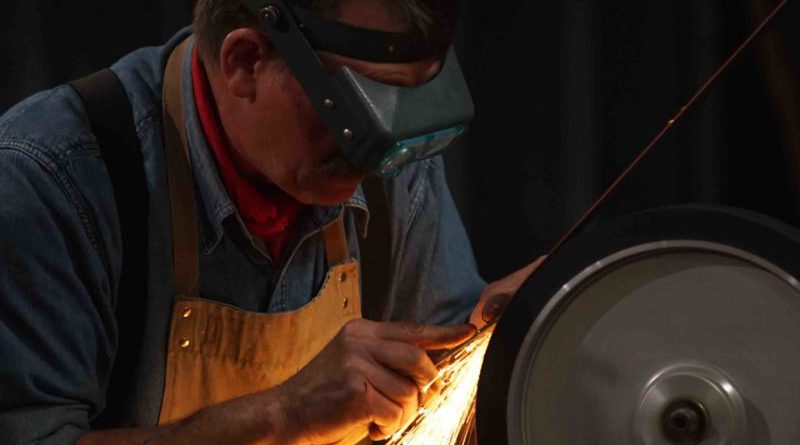INTERVIEW: History meets weaponry in new series, ‘Master of Arms’
Photo: Master of Arms is a new competitive reality series on Discovery Channel that finds craftspeople building blades, bows and firearms. Photo courtesy of Discovery.
Master of Arms, the new competitive reality series on Discovery, finds expert craftspeople working against the clock to follow historic traditions and build battle-ready armaments. The series, which includes four expert judges, will serve as a visual history lesson of blades, firearms and bows.
There will be many types of weapons used, including firearms of the frontier and blades of the Vikings. The series will jump thousands of years and visit many cultures along the way. Master of Arms premieres Friday, Nov. 2 at 10 p.m.
Among the expert judges is Ashley Hlebinsky, a firearm historian and current curator of the Cody Firearms Museum, part of the Buffalo Bill Center of the West in Cody, Wyoming. Recently, she exchanged emails with Hollywood Soapbox about the new show. Questions and answers have been slightly edited for style.
How did you first become interested in historic weaponry?
I didn’t grow up around firearms, but I always had an interest in military history. Growing up, I would go to historic sites often, but I guess I never made the connection that I could have a career at a place like that. When I started college, my plan was to go into medicine, but freshman year, I went on a Civil War Medicine tour in Gettysburg. The guide spoke about how the advancements in weapons technology and ballistics really changed battlefield medicine. I had never thought about that connection before and wanted to learn more, so I switched my major to history and got an internship at a military museum in my hometown. There, I had to identify over 200 weapons ranging from the Civil War era to the Iraq War, and I decided to switch to the study of weaponry as a whole.
How intense does the competition get on the series?
For the competitors or the judges? Intense on both accounts! The first challenge, the Quick Draw, is anywhere from three to six hours, and the competitors make the weapons in front of us. That always got really intense because not only did they have a short amount of time and cameras following them, they had the judges watching. It was hard for us, too, because we were up on a catwalk and could see everything, so when someone was searching for something or trying to problem solve, it took a lot of restraint for us not to call out to them to help.
How much history do you need to know to build these objects?
While all the challenges are rooted in history, not all of them had to be an identical reproduction. Just because a weapon is considered historic, doesn’t mean that it necessarily was designed well; we often gave the competitors a chance to improve on history. I provided a basic historical overview of each weapon before the challenge, so they more had to pull from their expertise of different historic building techniques. The competitors not only didn’t know what they were making going into the competition, they didn’t even know if it would be a blade, bow or firearm. We had gunsmiths making blades and bladesmiths making guns, so they really had to rely on base knowledge of metal and wood working to figure out how to make a workable finished product.
What do you say to viewers who are not fans of guns or the history of weaponry? It can be a controversial topic.
While the museum I run is a firearms museum, it is in the same building as other museums from art to natural science, so we get a lot of people through the door that do not know or in some cases even like firearms. However, blades, bows and firearms have been made for a variety of reasons over the years, so our visitors are usually surprised that there is something within that history that they can connect with. The same can be said about the show. Throughout history, weapons were not only a tool for war and sport, but also a highly sought-after decorative art, and the people making them were respected as artists. Our show examines early weaponry and highlights not only that process of design and creation, but also emphasizes what having these weapons would have meant to a soldier on the battlefield. Understanding this early history too can help lay a stronger foundation to understanding how cultures and attitudes have changed throughout time.
Do you like being on a reality series and the long hours of filming?
I really liked it. I run a museum that is in the middle of a renovation, so one minute I’m writing panels and labels, another minute I’m speaking to a donor, and another, I’m peeling vinyl off of glass cases. And while I love being able to do a little bit of everything, the schedule and consistency of the filming was actually a welcome change. Although I should point out that, during the filming, I was still putting in a 40-hour work week remotely at the museum. … I got really good at taking conference calls while in hair and makeup, and the AD’s got really good at tracking me down when I stepped out to take a call!
By John Soltes / Publisher / John@HollywoodSoapbox.com
Master of Arms premieres Friday, Nov. 2 at 10 p.m. on Discovery Channel. Click here for more information.

